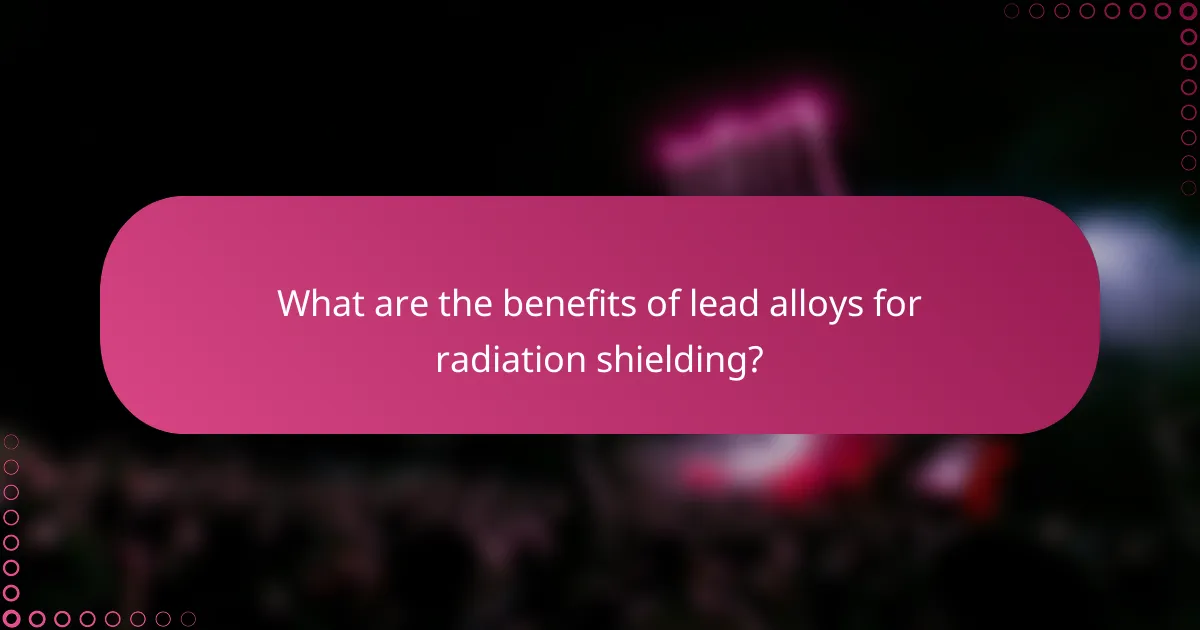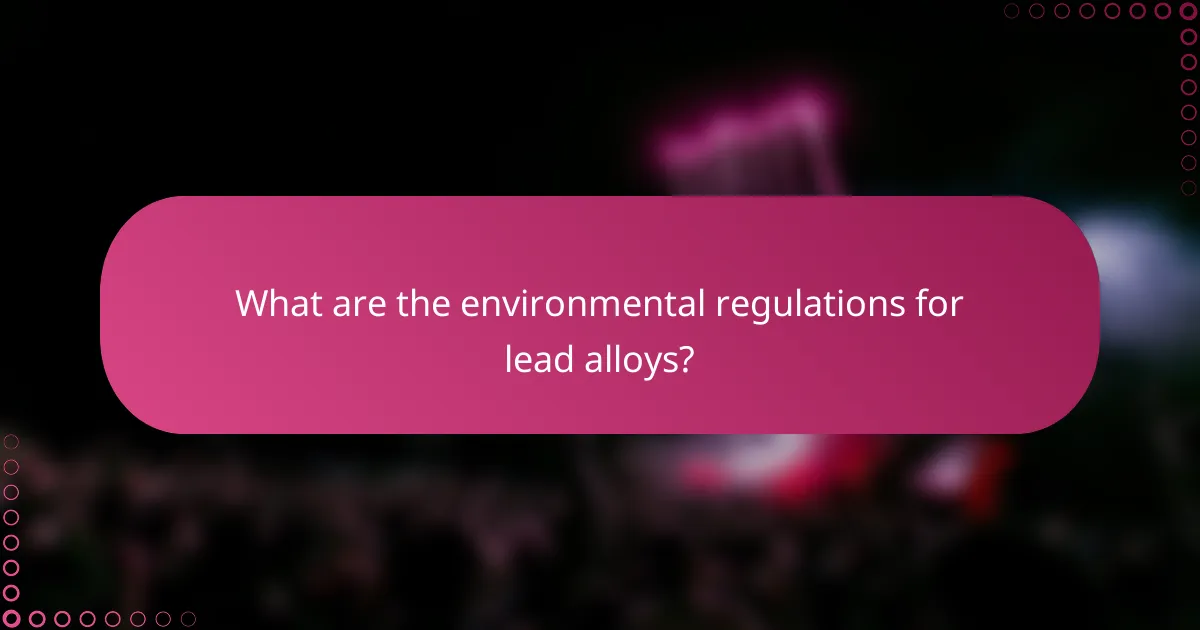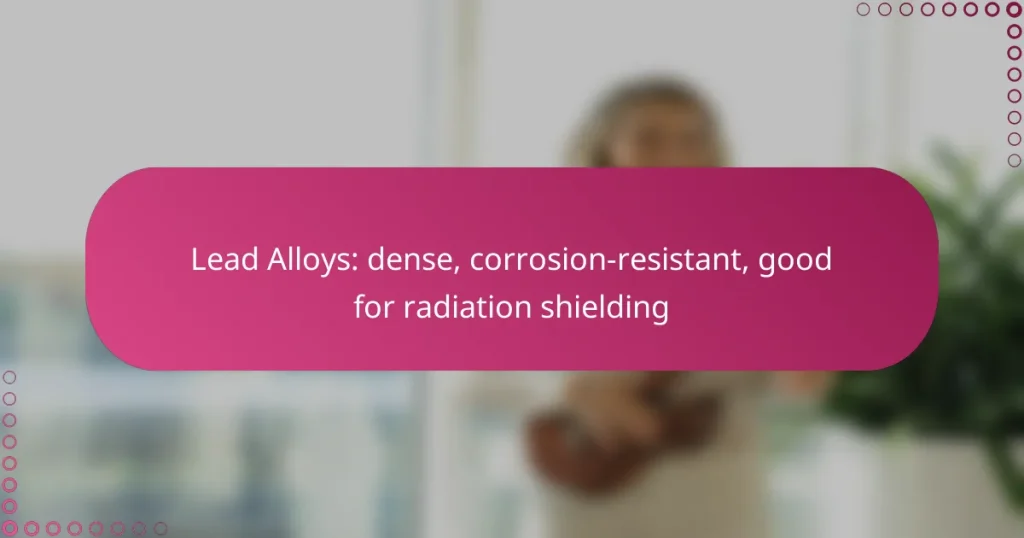Lead alloys are highly valued for their exceptional density, corrosion resistance, and effectiveness in radiation shielding, making them indispensable in medical, industrial, and nuclear applications. Their unique properties ensure safety and durability in environments where radiation protection is critical. Various types of lead alloys, such as lead-antimony, lead-tin, and lead-calcium, cater to specific needs, enhancing their versatility in practical applications.

What are the benefits of lead alloys for radiation shielding?
Lead alloys offer significant advantages for radiation shielding due to their high density, corrosion resistance, and cost-effectiveness. These properties make them ideal for applications in medical, industrial, and nuclear settings where effective radiation protection is essential.
High density for effective shielding
The high density of lead alloys makes them particularly effective at attenuating radiation. This density allows for a thinner barrier compared to lighter materials, which can result in space and weight savings in shielding applications. For instance, a lead alloy shield may require only a few centimeters of thickness to achieve the same level of protection that would need several centimeters of concrete.
In practical terms, lead alloys can reduce radiation exposure significantly, making them a preferred choice in environments such as hospitals and research facilities where radiation is prevalent. The effectiveness of lead alloys is often measured in terms of half-value layers, where a small number of layers can substantially decrease radiation intensity.
Corrosion resistance in harsh environments
Lead alloys are known for their corrosion resistance, which is crucial in environments that may expose materials to moisture or chemicals. This property ensures that lead shields maintain their integrity over time, providing reliable protection without the need for frequent replacements or repairs. For example, lead alloys can be used in marine applications where exposure to saltwater could degrade other materials.
Additionally, the corrosion resistance of lead alloys allows them to perform well in various industrial settings, including those involving radiation sources that may emit corrosive byproducts. This durability contributes to lower maintenance costs and longer service life for shielding installations.
Cost-effective compared to alternatives
Lead alloys are generally more cost-effective than many alternative materials used for radiation shielding. While initial material costs may be higher, the longevity and reduced maintenance requirements often lead to lower total lifecycle costs. For example, while materials like tungsten or specialized polymers may offer some benefits, their higher upfront costs and potential need for more frequent replacement can make lead alloys a more economical choice.
Furthermore, the ease of fabrication and installation of lead alloys can also contribute to cost savings in projects. Their availability in various forms, such as sheets or castings, allows for flexibility in design and application, making them accessible for a wide range of shielding needs.

How are lead alloys used in construction?
Lead alloys are utilized in construction primarily for their density, corrosion resistance, and effectiveness in radiation shielding. These properties make them ideal for specific applications where safety and durability are paramount.
Used in radiation therapy rooms
In radiation therapy rooms, lead alloys are essential for shielding patients and medical staff from harmful radiation exposure. The dense nature of lead effectively absorbs radiation, minimizing the risk of side effects during treatments.
Typically, walls, doors, and windows in these facilities are lined with lead or lead alloy materials to create safe environments. The thickness of the lead shielding often depends on the type of radiation used and the required safety standards, which can vary by region.
Application in nuclear facilities
Lead alloys play a critical role in nuclear facilities, where they are used for radiation shielding and containment. Their ability to withstand corrosive environments while providing effective radiation protection makes them a preferred choice in these settings.
In nuclear power plants, lead is often used in the construction of storage containers for radioactive materials. The design and thickness of these containers are determined by regulatory standards, ensuring safety and compliance with local regulations.

What types of lead alloys are available?
Lead alloys come in several types, each with unique properties suited for specific applications. The most common lead alloys include lead-antimony, lead-tin, and lead-calcium, each offering distinct advantages in terms of density, corrosion resistance, and suitability for radiation shielding.
Lead-antimony alloys
Lead-antimony alloys are primarily used in battery manufacturing and radiation shielding due to their excellent corrosion resistance and mechanical strength. The addition of antimony enhances the hardness of lead, making it more durable and suitable for applications where wear and tear are concerns.
These alloys typically contain around 5-15% antimony, which significantly improves their performance in harsh environments. However, it’s important to consider that higher antimony content can lead to increased brittleness, so balancing the composition is crucial.
Lead-tin alloys
Lead-tin alloys are commonly used in soldering applications, particularly in electronics and plumbing. The presence of tin improves the alloy’s fluidity and reduces the melting point, making it easier to work with during soldering processes.
These alloys usually consist of about 5-40% tin, allowing for a good balance between strength and ductility. When selecting a lead-tin alloy, it’s essential to consider the specific application requirements, as some formulations may be more suited for high-temperature environments than others.
Lead-calcium alloys
Lead-calcium alloys are primarily used in lead-acid batteries, offering improved performance and longevity compared to traditional lead-antimony batteries. The calcium content helps reduce water loss and enhances the overall efficiency of the battery.
Typically containing around 0.5-2% calcium, these alloys are particularly advantageous in applications where maintenance-free operation is desired. However, they may be less effective in extreme temperatures, so it’s important to evaluate the operating conditions before choosing this type of alloy.

How to choose the right lead alloy for your project?
Choosing the right lead alloy involves assessing its properties, such as density and corrosion resistance, alongside practical considerations like cost and availability. Understanding these factors will help you select an alloy that meets your project’s specific requirements.
Consider density and corrosion resistance
Density is a crucial factor in lead alloys, especially for applications requiring effective radiation shielding. Higher density alloys provide better protection, making them ideal for medical or industrial uses where radiation exposure is a concern.
Corrosion resistance is equally important, particularly in environments where exposure to moisture or chemicals may occur. Alloys with additives like antimony or tin can enhance corrosion resistance, ensuring longevity and reliability in various applications.
Evaluate cost and availability
Cost is a significant consideration when selecting a lead alloy, as prices can vary based on the alloy composition and market demand. Generally, more specialized alloys may come at a premium, so balancing performance with budget constraints is essential.
Availability can also impact your choice. Some alloys may be readily available in local markets, while others might require special orders or imports. Checking local suppliers for stock and pricing can save time and reduce project delays.

What are the environmental regulations for lead alloys?
Environmental regulations for lead alloys focus on minimizing lead exposure due to its toxicity and potential health risks. These regulations are designed to protect both human health and the environment from the harmful effects of lead contamination.
Compliance with EPA standards
The Environmental Protection Agency (EPA) sets strict standards for lead emissions and disposal, particularly in industries that utilize lead alloys. Facilities must adhere to the National Emission Standards for Hazardous Air Pollutants (NESHAP) and ensure proper waste management practices to limit lead release into the environment.
Regular monitoring and reporting are required to demonstrate compliance. Companies may need to implement control technologies to reduce emissions and conduct risk assessments to evaluate potential lead exposure to workers and surrounding communities.
State-specific regulations in the US
In addition to federal regulations, many states have their own specific laws governing the use and disposal of lead alloys. These regulations can vary significantly, often imposing stricter limits on lead content in products or requiring additional safety measures.
For example, states like California have enacted the Proposition 65 law, which mandates warnings for products containing lead. Companies operating in multiple states should be aware of these variations and ensure compliance with both state and federal regulations to avoid penalties.

What are the alternatives to lead alloys?
Alternatives to lead alloys include materials that offer similar benefits in terms of density, corrosion resistance, and radiation shielding. Key options are tungsten-based alloys and polymer composites, each with distinct properties and applications.
Tungsten-based alloys
Tungsten-based alloys are known for their high density and excellent radiation shielding capabilities, making them a strong alternative to lead alloys. These materials typically contain tungsten combined with other metals, enhancing their mechanical properties and corrosion resistance.
When considering tungsten alloys, it’s important to note that they can be more expensive than lead. However, they are often favored in high-performance applications, such as aerospace and medical equipment, where weight and durability are critical. The cost can range from several hundred to over a thousand USD per kilogram, depending on the specific alloy composition.
Polymer composites
Polymer composites provide a lightweight alternative to lead alloys while still offering decent radiation shielding. These materials combine polymers with heavy fillers, such as barium or tungsten, to enhance their density and protective qualities.
One advantage of polymer composites is their versatility in manufacturing, allowing for complex shapes and designs. They are often used in applications like radiation therapy equipment and protective gear. While they may not match the shielding effectiveness of lead or tungsten, they can be a cost-effective solution, typically priced lower than traditional metals, often in the range of tens to a few hundred USD per kilogram.

What are the safety considerations when handling lead alloys?
Handling lead alloys requires strict adherence to safety protocols due to the toxic nature of lead. Key considerations include using appropriate personal protective equipment (PPE), ensuring proper ventilation, and following established handling guidelines to minimize exposure risks.
Proper personal protective equipment (PPE)
When working with lead alloys, wearing the right personal protective equipment is essential to prevent lead exposure. Recommended PPE includes gloves, safety goggles, and respirators designed to filter out lead particles.
Gloves should be made of materials resistant to lead penetration, such as nitrile or rubber. Safety goggles protect the eyes from dust and splashes, while respirators help filter airborne lead particles, especially in poorly ventilated areas.
Regularly inspect PPE for wear and tear, and replace any damaged items immediately. Ensure that all personnel are trained in the proper use and maintenance of their protective gear to maximize safety during handling operations.


